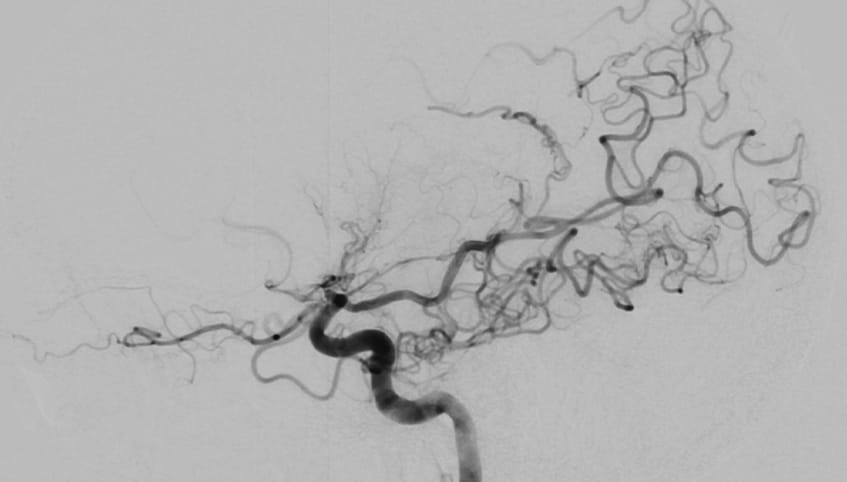- Home
- News Room
- Patient Stories
- Brain Surgery Helps Beat Rare Moyamoya Disease
October 14, 2019
Surgical technologist Jason Edwards was at work in the operating room at North Kansas City Hospital when his right arm went limp.
"I lost complete feeling and motor skills in that arm," he says. "I called my wife. She said I sounded like I was slurring my words."
Suspecting a stroke or transient ischemic attack (TIA), Jason stepped out of the operating room and into the emergency room. A neurologist confirmed the TIA, but also suspected moyamoya disease, a rare blood vessel disorder. She referred him to The University of Kansas Health System, the only hospital in the area with experience treating the disorder.
A rare condition
The walls of Jason's carotid artery had thickened, reducing blood flow to his brain. To compensate, tiny blood vessels opened at the base of his brain in an attempt to supply blood. However, the cluster of small vessels could not do the job of the major artery, and the lack of blood to his brain caused Jason's stroke.
Moyamoya disease can cause a ministroke, an aneurysm (ballooning of a blood vessel) or bleeding in the brain. It can affect brain function and cause cognitive and developmental delays or disabilities in children.
Found all over the world, moyamoya disease – named for the “puff of smoke” the small blood vessels resemble – is most common in East Asian countries and among people of East Asian descent. To his knowledge, Jason doesn't have Asian ancestry, which makes his case even more unusual.

Sophisticated diagnosis
At the health system, specialists injected dye into Jason's brain to visualize the blood flow. The test, known as a cerebral angiogram, confirmed the moyamoya disease diagnosis. The carotid artery on the left side of Jason's brain was 98% blocked, the telltale cluster of small vessels clearly visible.
At this point, an experienced neurosurgeon would typically explain the surgery the patient required.
"But I already knew all about it," Jason says. "In my job, I'm the guy who sets up all the sterile instruments and passes them to the doctor during the case. And I've scrubbed in with Dr. Paul Camarata quite a bit."
The health system's former chief of neurosurgery, Paul Camarata, MD, has performed hundreds of moyamoya surgeries over his career.
"I couldn't have asked for better," Jason says. "He is a really good surgeon. He is compassionate and cares about his patients."
Successful surgeries
Just 2 weeks after experiencing the TIA, Jason, age 38, had surgery on the left side of his brain. During the procedure, Dr. Camarata performed a bypass of the tangled, small vessels.
"We essentially took a vessel from Jason's temporal artery, dropped it down inside his brain and reattached it to the main blood vessel in his brain," Dr. Camarata says.
After the surgery, Jason noticed greater strength in his right arm. He was back to work in the operating room at North Kansas City Hospital a month later.
"Before I had the original TIA, I would have issues where my right leg would give out on me if I was standing or walking," Jason says. "That also went away after the surgery."
Dr. Camarata believes Jason may have had undetected ministrokes leading up to the TIA. Looking back, Jason thinks the heart failure he was diagnosed with in 2009 from hypertension (high blood pressure) also might have been caused by moyamoya disease.
Dr. Camarata monitored Jason closely through follow-up visits. A little over a year later, Jason began showing signs of moyamoya disease on his right side. Dr. Camarata wasted no time. He scheduled Jason for a second surgery – this time performing a bypass on the right side of Jason's brain. A month later, Jason went back to work.
"Moyamoya disease is rare, so it can be difficult for neurosurgeons to come across it and build experience treating it," Dr. Camarata explains. "But when those complex cases are recognized, they come to places like The University of Kansas Health System – large, academic medical centers with the expertise and technologies to provide effective care. Jason is doing really well today and returns for checkups about once a year."
Back in the game
Aside from having trouble with his memory from time to time, Jason's only reminders of the surgeries are the scars on each side of his head, visible only because the military veteran chooses to keep his hair short.
This year, Jason celebrates his 18th year at North Kansas City Hospital. When he's not working, he enjoys playing Diablo and World of Warcraft on his computer. He lives in Richmond, Missouri, with his wife.
Patient testimonial: As with all treatments, individual patient results vary. It is important to discuss your treatment options with your healthcare provider.





